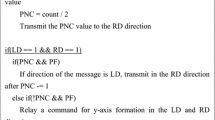Abstract
In future urban warfare scenarios, the expectations placed on unmanned aerial vehicles (UAVs) in terms of autonomy, reliability and cooperation will be significantly increased. In this paper, a novel algorithm is developed which enables a swarm UAVs to contain and intercept multiple evading targets. In particular, the algorithm allows a swarm of UAVs to intercept significantly faster evading targets if there are more UAVs than targets. Several numerical experiments are conducted, in which four pursuers attempt to intercept one or two faster evaders. The algorithm is very effective at containing the targets; however, as the number of evading targets increases the speed of the evaders must be reduced to ensure capture. Finally, a scenario in which there are more evading targets than pursuers is considered, and, given that the evaders were slower than the pursers, containment and capture was successfully accomplished.
Similar content being viewed by others
References
Office of the Secretary of Defense (Acquisition, Technology, & Logistics), Air Warfare.: OSD UAV Roadmap 2002–2027 (2002, December)
Reimann, J., Vachtsevanos, G., Ge, J., Tang, L.: An approach to controlling swarms of unmanned aerial vehicles in adversarial situations. In: AIAA Guidance, Navigation and Control Conference, Keystone, CO (2006)
Sethian, J., Vladimirsky, A.: Ordered upwind method for Static Hamilton–Jacobi equations: Theory and algorithms. SIAM J. Numer. Anal., 41(1), 325–363 (2003)
Stipanovic, D., Sriram, Tomlin, C.: Strategies for agents in multi-player pursuitevasion games. In: Eleventh International Symposium on Dynamic Games and Applications (2004)
Kao, C., Osher, S., Qian, J.: Lax-Friedrichs sweeping scheme for static Hamilton–Jacobi equations. J. Comput. Phys., 196, 367–391 (2004)
Antoniades, A., Kim, H., Sastry, S.: Pursuit–evasion strategies for multiple agents with incomplete information. In: Proceedings of the 42nd IEEE Conference on Decision and Control, pp. 756–761 (2003)
Isler, V., Belta, C., Daniilidis, K., Pappas, G.: Hybrid control for visibility-based pursuit–evasion games. In: Proceedings of 2004 IEEE International Conference on Intelligent Robots and Systems, pp. 1432–1438 (2004)
Souganidis, P.: Two-player, zero-sum differential games and viscosity solutions. Annals of the International Society of Dynamic Games, 4, 69–104 (1999)
Sethian, J.: Adaptive fast marching and level set methods for propagating interfaces. Acta Math. Univ. Comen., LXVII, 3–15 (1998)
Harten, A., Engquist, B., Osher, S., Chakravarthy, S.: Uniformly high-order accurate essentially non-oscillatory schemes III. J. Comput. Phys., 71, 231–303 (1987) (also ICASE Report no. 86–22, April 1986)
Author information
Authors and Affiliations
Corresponding author
Rights and permissions
About this article
Cite this article
Reimann, J., Vachtsevanos, G. UAVs in Urban Operations: Target Interception and Containment. J Intell Robot Syst 47, 383–396 (2006). https://doi.org/10.1007/s10846-006-9089-6
Received:
Accepted:
Published:
Issue Date:
DOI: https://doi.org/10.1007/s10846-006-9089-6




